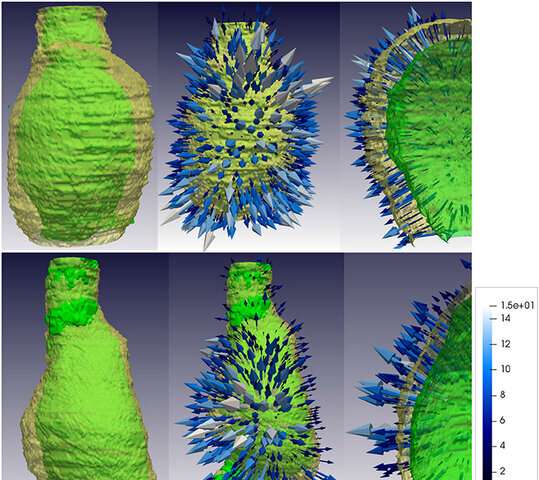Advances in the detection of the postoperative progress of abdominal aortic aneurysm

An abdominal aortic aneurysm is a focal dilation of the abdominal aorta, that if not treated, tends to grow and may rupture. The most common treatment is endovascular aneurysm repair (EVAR), which requires patients to undergo lifelong postoperative surveillance based on computed tomography angiography (CTA) due to the possible appearance of complications. These complications may again lead to aneurysm dilation and rupture.
To monitor the disease, advanced tools for the quantitative analysis of clinical images to support physicians are lacking. Currently, the approach consists of evaluating diameter changes to the aneurysm through time to infer the progress of the patient and the postoperative risk of aneurysm rupture. An increased diameter is usually associated with a higher rupture risk, but there are some small aneurysms that rupture, whereas other larger ones remain stable.
This means that diameter-based rupture risk assessment is not suitable for all cases, and there is increasing evidence that the biomechanical behaviour of the aneurysm may provide additional valuable information regarding the progression of the disease and the risk of rupture.
A study published recently in Frontiers in Bioengineering and Biotechnology, coordinated by Miguel A. González Ballester (ICREA-DTIC) and Iván Macía (VicomTech), offers a promising methodology for post-operative CTA time-series registration and subsequent aneurysm biomechanical strain analysis, which correlates with the patient's long-term prognosis.
The study was conducted entirely in Catalonia and the Basque Country by researchers from the BCN-MedTech Research Unit of the Department of Information and Communication Technologies (DTIC) at UPF, together with centres in the Basque Country: VicomTech Foundation of San Sebastián, the Bioengineering area of the BioDonostia Health Research Institute and Donostia University Hospital.
Quantitative descriptors extracted from registrations of deformations of the aorta
From the deformations obtained from CTA image registration, the researchers have extracted quantitative descriptors of the main components of the tensile and compressive strain fields. "Evaluated on 22 patients, our approach yields a mean area under the curve of 88.6% when correlating the strain-based quantitative descriptors with the long-term patient prognosis," says Karen López-Linares, first author of the work, linked to the SIMBIOsys research group and researcher at BCN-MedTech, the VicomTech Foundation and the BioDonostia Health Research Institute.
"This suggests that the descriptors directly extracted from the CTA images are able to capture the biomechanical behaviour of the aneurysm without relying on finite element modelling and simulation," add Jérôme Noailly, a specialist in computational biomechanics, and Miguel A. González Ballester (ICREA DTIC), both members of BCN-MedTech and co-authors of the article.
Biomarkers for the most difficult and uncertain cases of aneurysm
In addition, the authors highlight that the extracted descriptors set the basis for possible future imaging biomarkers that may be used in clinical practice. These biomarkers may be used to assess patient prognosis and to enable informed decision making after an EVAR intervention, the most common treatment for aortic and abdominal aneurysms, and especially in difficult, uncertain cases.
More information: Karen López-Linares et al, Image-Based 3D Characterization of Abdominal Aortic Aneurysm Deformation After Endovascular Aneurysm Repair, Frontiers in Bioengineering and Biotechnology (2019). DOI: 10.3389/fbioe.2019.00267

















